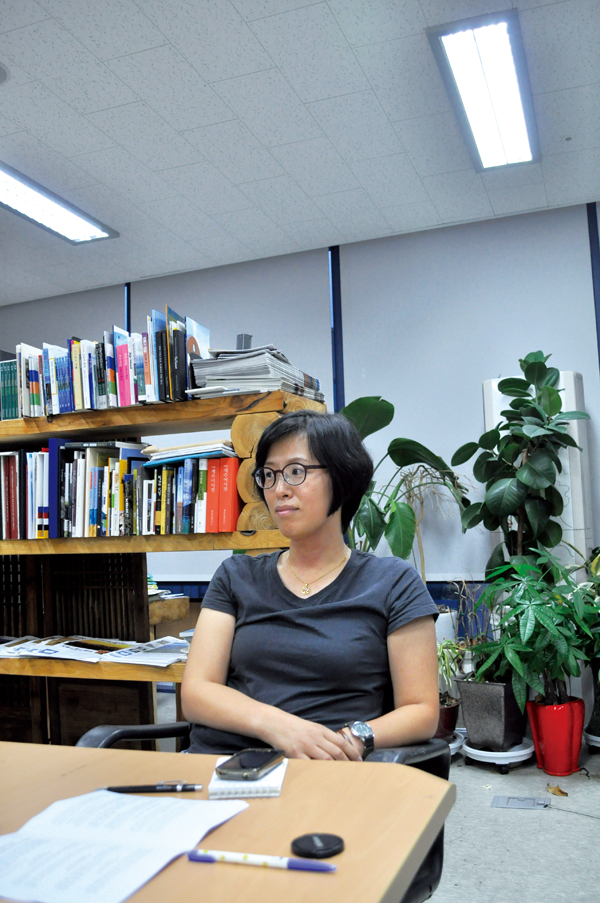
- Updated 2024.4.24 17:16
- All Articles
-
member
icon
-
facebook
cursor
-
twitter
cursor
| |
 |
|
| ▲ An animation by Byun Geum-Yun where two depictions of herself are constantly turning over their shoulders in an attempt to look the other in the eye, a metaphor for the question that most influences her work, “Who am I?” Photo courtesy The artist |
For artist Byun Geum-Yun, art is the journey to understanding the self.
“Who am I,” Byun says is the question she constantly asks herself and a theme that inspires much of her work. Even though many of her pieces deal with the island’s history, she internalizes the stories and attempts to see how they have affected who she truly is.
“As an example,” Byun said, “my grandmother went through all of [Jeju’s] hard histories. She was born during the Japanese occupation, saw the liberation, but experienced 4.3 [the Jeju Massacre]. Her husband went to Japan to avoid it, and then the Korea War happened and she lost her eldest son from it. She experienced all these hardships.”
Byun says that when she was young these hardships only resulted in her seeing her grandmother as “tough and scary,” but after becoming an adult and researching the massacre and other aspects of Jeju’s history, “I realized these [events] were something related to people who are beside me like my grandmother or father.” Now she attempts to portray these histories “through the story of my grandmother inside me.”
In 2005, while doing research on Jeju’s past and trying to understand herself within its context, she became interested in the 5.16 Road. She uses the 5.16 Road everyday for her commute from Seogwipo to Jeju City for work and “the road was telling me so much [of its] story,” she said, explaining that “I wanted to find the relationship between that road and myself, as a daily trespasser, as well as the meaning of that road.”
When she began to work on this project, which became a documentary called “5.16 Road Project,” she conducted a survey to see if people understood the significance of its name, and no one knew.
“5.16” is the date of the May 16 Coup d’Etat in 1961 by Park Chung Hee, who would then become South Korea’s dictator for the following 18 years. Byun begins her film defining the road as the “representation of [Park’s] totalitarian government.”
With her film she attempts to bring to light the true meaning of the road, which she sees as its beauty, its winding structure, and ecology which she believes has been suppressed by its christened name.
These histories, imbued in the people of Jeju, she credits as a women of Jeju for the darkness in her life and for when she feels depressed. “I think the everyday life becomes history, and history becomes everyday life,” she offered as an explanation. And because of the connection she feels with Jeju due to her family, in how examining the history of Jeju can reveal something about who she is, she feels that through investigating herself, she can unveil something about Jeju. Her example; “I would want to talk about the ecology and environment through my backyard.”
| |
 |
|
| ▲ Photos by Darryl Coote |
Now, working in the Venture Maru Building for the Culture Contents department, which mainly consists of administrative duties with some art, her artistic endeavors have delved into examining the self through deep philosophical questions we ask everyday without realizing it.
She said that in her office at exactly 11:50 a.m. her coworkers always ask ‘what are we going to eat today?’ “But that’s actually a very important question,” she said and when she began to think about it and examined her coworkers on what they wanted to eat and why they began to look at her as if she were off her rocker. “I think an artist is someone who finds something significant in ordinary life and helps others to do so, too,” she said.
When asked what kind of artist she is — a mixed-media artist or a video artist — she said that those are only mediums and that an artist is someone who communicates to the larger world aspects of ourselves, of our world that we interact with daily without notice.
“If we smell something really strong, and continue smelling it, then our sense will dull and won’t recognize the smell anymore, and that’s like us getting dull from our life. Artists should know that there is this smell all the time,” and communicate it to the rest of the world, she said.
(Interpretation and transcription by Oh Ji Su)
|
|
|
|
|
|
|
 Darryl Coote의 다른기사 보기 Darryl Coote의 다른기사 보기 |
|
ⓒ Jeju Weekly 2009 (http://www.jejuweekly.net)
All materials on this site are protected under the Korean Copyright Law and may not be reproduced, distributed, transmitted, displayed, published without the prior consent of Jeju Weekly. |
|
|
|
|
| Jeju-Asia's No.1 for Cruise |
|
|
|
Title:The jeju Weekly(제주위클리) | Mail to editor@jejuweekly.net | Phone: +82-64-724-7776 Fax: +82-64-724-7796
#503, 36-1, Seogwang-ro, Jeju-si, Jeju-do, Korea, 63148
Registration Number: Jeju, Ah01158(제주,아01158) | Date of Registration: November 10,2022 | Publisher&Editor : Hee Tak Ko | Youth policy: Hee Tak Ko
Copyright ⓒ 2009 All materials on this site are protected under the Korean Copyright Law and may not be reproduced, distributed, transmitted, displayed, published
without the prior consent of jeju weekly.com.

|





















